![]()
![]()
![]()
Use LEFT and RIGHT arrow keys to navigate between flashcards;
Use UP and DOWN arrow keys to flip the card;
H to show hint;
A reads text to speech;
31 Cards in this Set
- Front
- Back
|
What is massive reabsorption in proximal tubule (in terms of osmolarity)?
What is final urine excreted? What are specialized to form urine with variable osmolarity? What do most regulatory mechanisms target? |
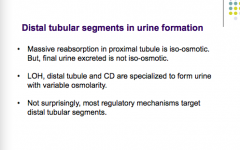
|
|
|
What composes the distal segments of tubule?
What are the three structures of the loop of Henle? |
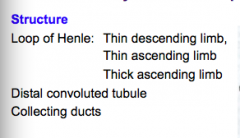
|
|
|
What are the functions of the distal segments?
Osmolarity, Na+, K+, Ca2+, Mg2+, PO4, H+ |
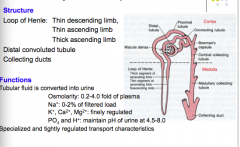
|
|
|
What is the structure of the thin descending limb loop of Henle?
|

|
|
|
What is the interstitial environment in the thin descending loop of Henle?
Relationship to plasma, increase or decrease, what is the maximum reached? |
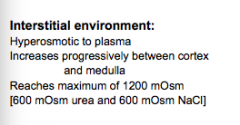
|
|
|
What is the function of the thin descending limb loop of Henle?
Tubular fluid, active transepithelial transport, water permeability, permeability to NaCl and urea, driving force? |

|
|
|
What are the transport properties of the thin ascending limb with regard to urea, water, and NaCl?
Water, urea, NaCl, tubular fluid to ISF urea gradient? What happens to osmolarity and why? |
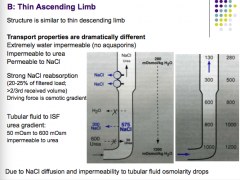
|
|
|
Where is the thick ascending limb located?
Describe the epithelial cells (thickness and mitochondria) Transport properties: NaCl, water, mechanism Transporters: Three, what does each do? |
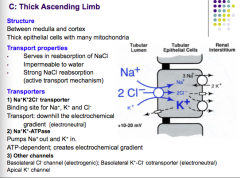
|
|
|
Regulation of NK2C: Draw out the pathway.
Which diuretics are more efficient and why? |
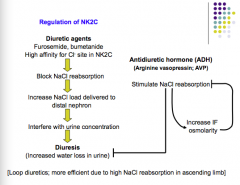
|
|
|
Distal convoluted tubule (DCT) runs from__________________ Six-to-eight DCTs join together to form_______________.
CDs start in _________ and run down to __________. CDs join together in__________ to form duct of __________. Distinct cell types in DCT and CD, but functions are similar. |
Distal convoluted tubule (DCT) runs from thick ascending limb. Six-to-eight DCTs join together to form collecting duct.
CDs start in cortex and run down to medulla CDs join together in medulla to form duct of Bellini. Distinct cell types in DCT and CD, but functions are similar. |
|
|
Comment on tubular fluid processing in the DC and CD: Na+, K+
Effect of Na+/K+ on Cl- What is the net result? |

Dilution of tubular fluid (if impermeable to water)
|
|
|
What is the water permeability in the DC and CD?
In water diuresis and in dehydration? |

|
|
|
What are the two distinct transport mechanisms for Na+ reabsorption in the DCT and CD? Which is only present in the DCT?
|
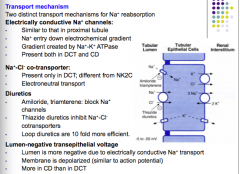
|
|
|
What diurectics block Na+ channels? Na-Cl cotransporters? Which are 10-fold more efficient?
|

|
|
|
What is the lumen transepithelial voltage (+ or -) and why? Is the membrane depolarized? More in CD or DCT?
|

|
|
|
Comment on potassium secretion: direction of movemement and driving forces.
|

|
|
|
What are the regulatory factors of potassium? Think about effects of fluid flow and delivery of Na+ to distal tubule.
|

|
|
|
What are the effects of diuretics on potassium balance?
Loop diuretics Thiazides Amilorides |

|
|
|
What is aldosterone? Secreted from what? Acts exclusively on what parts of nephon?
|

|
|
|
What are the actions of aldosterone? How does it affect Na+ and K+?
|

|
|
|
What is the mechanism of aldosterone's effects?
|

|
|
|
What changes in the cell does aldosterone cause?
Na+ channel number Synthesis of something --> Synthesis of certain enzymes Increased activity of ?? |

|
|
|
What disease results in a complete absence of aldosterone?
What does this cause? |

Addison's disease
|
|
|
What is Conn's Syndrome?
What does it cause? |

Aldosterone secreting tumor
|
|
|
What is Liddle's Syndrome?
|
Pseudo hyperaldosterinism
|
|
|
What are some factors that increase aldosterone secretion?
What are some factors that decrease secretion? |

|
|
|
Where does final acidification of urine occur?
What is reabsorbed and what is secreted? What are the cell types? What is each responsible for? |
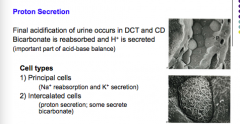
|
|
|
What is used to generate H+? How is it secreted to the lumen?
Because it is secreted against the electrochemical gradient, what does it require? What is important to diffusion in contrast to the proximal tubule? |

|
|
|
What drives transport of H+ from cell to lumen through apical channel? It's present in both the DCT and CD.
What does an increase in intracellualr HCO3- drive? Via what? What happens under high acidosis conditions? What pump? |
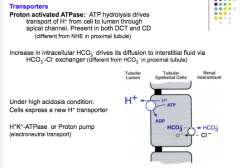
|
|
|
What happens under alkalosis condition?
Which channels switch? How is this achieved? Which cells? |

|
|
|
How does parathyroid hormone affect calcium reabsorption?
|
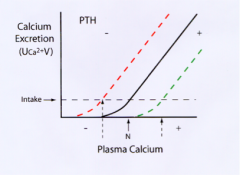
|

